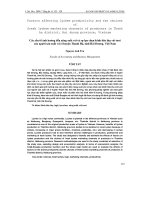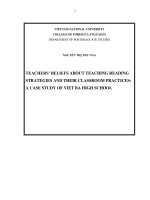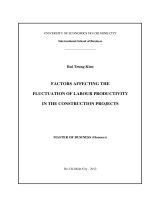Factors Affecting the Satisfaction of Customers in Bidv Vung Tau Branch Bank
Bạn đang xem bản rút gọn của tài liệu. Xem và tải ngay bản đầy đủ của tài liệu tại đây (280.45 KB, 2 trang )
<span class='text_page_counter'>(1)</span><div class='page_container' data-page=1>
Volume 4, Issue 5, May– 2019 International Journal of Innovative Science and Research Technology
ISSN No:-2456-2165
IJISRT19MY553 www.ijisrt.com 736
Factors Affecting the Satisfaction of Customers in
Bidv Vung Tau Branch Bank
Nguyen Thi Phuong Anh, Vu Van Dong
<b>Abstract:- This study was conducted to assess customer </b>
<b>satisfaction in substance amount of service. By </b>
<b>quantitative research, with a sample size of 150 clients </b>
<b>using products of BIDV Bank, Vung Tau Branch, </b>
<b>research results show that material (β = 0.173), sympathy </b>
<b>(β = 0.499) and reliability (β = 0.365) influence customer </b>
<b>satisfaction. Finally, the research sheds light some </b>
<b>managerial </b> <b>implications </b> <b>for </b> <b>improving </b> <b>customer </b>
<b>satisfaction on quality of banking services, give some </b>
<b>limitations and suggestions for future research. </b>
<b>I. </b> <b>INTRODUCTION </b>
Today, improving the quality of services performed by
banks is the surviving factor and target that banks pursue. It
is a trend and necessity in the commercial bank. Vietnam
Bank for Investment and Development of Vietnam (BIDV) is
not out that trend. BIDV is also trying to diversify its
products, improve service quality in order to aim BIDV to
become a leading retail bank in Vietnam, holding a large
share of outstanding loans, capital mobilization, and card
services with quality and top performance in Vietnam.
Therefore, the study of the factors that affect customer
satisfaction when using BIDV's products and services is very
necessary.
<b>II. </b> <b>THEORETICAL BACKGROUND </b>
<i>A. Model SERVPERF </i>
Cronin & amp; Taylor (1992) uses the 5-component
structure of service quality Parasuraman & amp; (1988), but
only the component of perceived success, named
SERVPERF scale. SERVPERF MODEL: Quality of Service
= Feeling
<i> When setting the SERVPERF scale, Cronin & amp; </i>
<i>Taylor (1992) uses these attributes </i>
SERVQUAL's quality of service but eliminates the
"expectation". Due to the origin of the scale measurement of
the SERVQUAL model, components and observation
variables of the SERVPERF model like SERVQUAL.
Therefore, this measurement model is also known as the
sensory model (Perception Model).
<i>B. The Relationship between Quality of Service and </i>
<i>Customer Satisfaction </i>
<i> Oliver (1993) argues that service quality affects the level </i>
<i>of satisfaction </i>
Customer. which is, quality of service is determined by
many factors, one part of the decisive factor of satisfaction.
The study used the SERVPERF model of Cronin & amp;
Taylor (1992) measured the quality of retail banking services
at BIDV, Vung Tau branch. Based on the results of the
qualitative research, the team members discussed that 03
Factors Explaining Customer Satisfaction on Retail Banking
Service Quality at BIDV, Vung Tau Branch shown in Figure
1.
Fig 1:- The proposed research model
Hypothesis H1: Reliability has the same effect on
customer satisfaction
Hypothesis H2: Sympathy influences the same way to
customer satisfaction
Hypothesis H3: Material affect the same way to customer
satisfaction
<b>III. </b> <b>RESEARCH DATA </b>
The official sample is chosen in a convenient manner
according to the principle 5: 1 (Bollen, 1989). Model has (17
variable observations) * 5 = 85 so the sample size is at least
85. The number of votes is 170 for BIDV branches and
transaction offices, Vung Tau branch. Number of votes
received 165 votes, of which 15 invalid votes, the remaining
150 votes invalid.
<b>IV. </b> <b>RESEARCH RESULTS </b>
</div>
<span class='text_page_counter'>(2)</span><div class='page_container' data-page=2>
Volume 4, Issue 5, May– 2019 International Journal of Innovative Science and Research Technology
ISSN No:-2456-2165
IJISRT19MY553 www.ijisrt.com 737
the observed variables are greater than 0.5, confirming
unidirectionality and convergent validity of the constructs.
Thus, the saturated model matches with the market data.
SEM results (Figure 2) theoretical model: χ2 [98] =
175; p = 0.000; CMIN / df = 1,782 < 2; GFI = 0.876; TLI =
0.941; CFI = 0.952; RMSEA = 0.072. The Heywood
phenomenon does not appear during the estimation of CFA
and SEM models. Thus, it is possible to conclude the model.
This is suitable for the market data.
Relationships Estimate C.R. P
B S.E. b
Satisfaction <--- Material 0.198 0.078 0.173 2.535 0.011
Satisfaction <--- Sympathy 0.526 0.107 0.499 4.928 ***
Satisfaction <--- Reliability 0.373 0.101 0.365 3.680 ***
Table 1:- SEM model estimation results
<b>Note: B: unstandardized estimates, b: standardized estimates </b>
Estimates of key parameters are presented in Table 1.
Accordingly, sympathy has the strongest positive effect on
satisfaction (β = 0.499; p = 0.000); Next, reliability has a
positive effect on customer satisfaction (β = 0.365; p =
0.000). Finally, material has a positive effect on customer
satisfaction (β = 0.173; p = 0.011).
<b>V. </b> <b>CONCLUSIONS AND MANAGERIAL </b>
<b>IMPLICATIONS </b>
<i>A. Conclusions </i>
This research demonstrated the positive relationships
between the components of service quality and customer
satisfaction. Research results are consistent with prior
research. The proposed hypotheses are accepted, no
hypotheses are rejected.
<i>B. Managerial implications </i>
Improving the sympathy factor: Helping customers in the
process of using the service, maintaining relationships
with customers: Send thanks’s letters, congratulatory
letters, occasional visits, Tet holidays ... and implement
customer appreciation program.
Improved the reliability factor: Improved procedures and
transaction process, automated transaction execution to
minimize customer transaction time, actively improve old
services and develop new services to increase utilities for
customers, and enhance the consulting and customer
support.
Improved the material factor : Invest in upgrading the
facilities and equipment of the transaction network. Build
up facilities, attractive customers and modern equipment
system to serve customers. Designing counters,
customer’s transaction point with beautiful and
professional and modern machinery.
<b>REFERENCES </b>
[1]. Cronin, J. J., & Taylor, (1992). Measuring Service
Quality: A Reexamination and Extension. Journal of
Marketing, 56, 55-68.
[2]. Oliver, R.L. (1993). A conceptual model of service
quality and service satisfaction: different goals', in
Swartz, T.A., Bowen, D.E. and Brown, S.W. (Eds).
Advances in Services Marketing and Management:
Research and Practice, 2nd ed., JAI Press, Greenwich,
CT, pp. 65-85
</div>
<!--links-->
THE FACTORS AFFECTING THE USE OF ELDERLY CARE AND THE NEED FOR RESOURCES BY 2030 IN FINLAND pot
- 56
- 625
- 0








